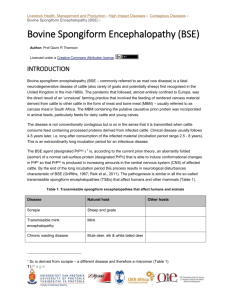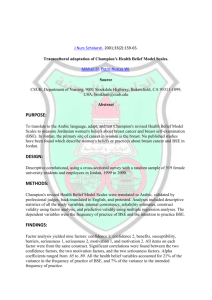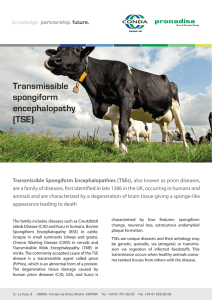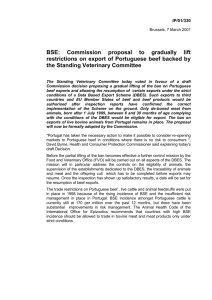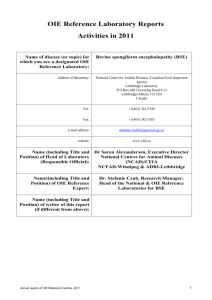bse_4_diagnosis
advertisement
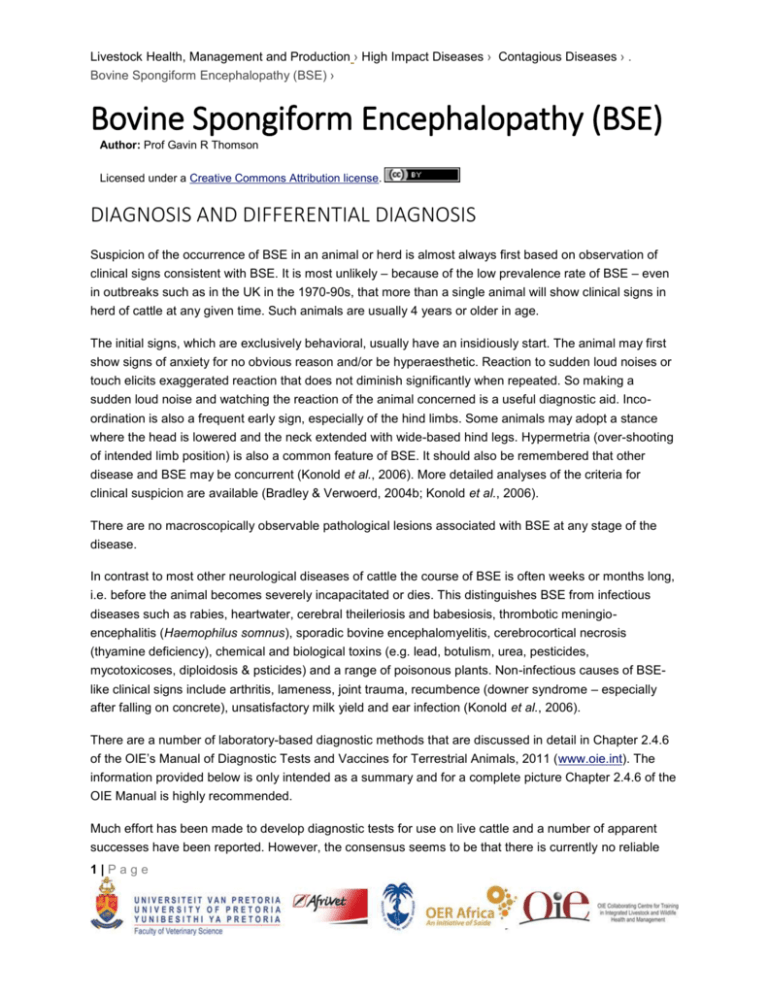
Livestock Health, Management and Production › High Impact Diseases › Contagious Diseases › . Bovine Spongiform Encephalopathy (BSE) › Bovine Spongiform Encephalopathy (BSE) Author: Prof Gavin R Thomson Licensed under a Creative Commons Attribution license. DIAGNOSIS AND DIFFERENTIAL DIAGNOSIS Suspicion of the occurrence of BSE in an animal or herd is almost always first based on observation of clinical signs consistent with BSE. It is most unlikely ‒ because of the low prevalence rate of BSE ‒ even in outbreaks such as in the UK in the 1970-90s, that more than a single animal will show clinical signs in herd of cattle at any given time. Such animals are usually 4 years or older in age. The initial signs, which are exclusively behavioral, usually have an insidiously start. The animal may first show signs of anxiety for no obvious reason and/or be hyperaesthetic. Reaction to sudden loud noises or touch elicits exaggerated reaction that does not diminish significantly when repeated. So making a sudden loud noise and watching the reaction of the animal concerned is a useful diagnostic aid. Incoordination is also a frequent early sign, especially of the hind limbs. Some animals may adopt a stance where the head is lowered and the neck extended with wide-based hind legs. Hypermetria (over-shooting of intended limb position) is also a common feature of BSE. It should also be remembered that other disease and BSE may be concurrent (Konold et al., 2006). More detailed analyses of the criteria for clinical suspicion are available (Bradley & Verwoerd, 2004b; Konold et al., 2006). There are no macroscopically observable pathological lesions associated with BSE at any stage of the disease. In contrast to most other neurological diseases of cattle the course of BSE is often weeks or months long, i.e. before the animal becomes severely incapacitated or dies. This distinguishes BSE from infectious diseases such as rabies, heartwater, cerebral theileriosis and babesiosis, thrombotic meningioencephalitis (Haemophilus somnus), sporadic bovine encephalomyelitis, cerebrocortical necrosis (thyamine deficiency), chemical and biological toxins (e.g. lead, botulism, urea, pesticides, mycotoxicoses, diploidosis & psticides) and a range of poisonous plants. Non-infectious causes of BSElike clinical signs include arthritis, lameness, joint trauma, recumbence (downer syndrome – especially after falling on concrete), unsatisfactory milk yield and ear infection (Konold et al., 2006). There are a number of laboratory-based diagnostic methods that are discussed in detail in Chapter 2.4.6 of the OIE’s Manual of Diagnostic Tests and Vaccines for Terrestrial Animals, 2011 (www.oie.int). The information provided below is only intended as a summary and for a complete picture Chapter 2.4.6 of the OIE Manual is highly recommended. Much effort has been made to develop diagnostic tests for use on live cattle and a number of apparent successes have been reported. However, the consensus seems to be that there is currently no reliable 1|Page Livestock Health, Management and Production › High Impact Diseases › Contagious Diseases › . Bovine Spongiform Encephalopathy (BSE) › test available for use on live animals. All diagnostic methods are based on histopathology and/or identification of the presence of PrPSc in the brains of suspect cases. Histology – which enabled the observation of typical TSE-associated vacuolation in the brainstem, particularly at the level of the obex ‒ was initially the only diagnostic test available. In situations where large numbers of samples have to be examined this approach, even when enhanced by use of immunohistochemistry (IHC) is cumbersome and time consuming, especially if the brain has to be removed from the skull. For that reason sampling methods that retrieve samples of the brainstem through the medulla oblongata were developed. These are depicted in Chapter 2.4.6 of the OIE Manual (see above & www.oie.int). Negative staining of extracts of brain material treated with detergents also enable diagnosis by electron microscopy but this method is now seldom used as a routine. Similarly, biological testing using specific strains of laboratory mice is also possible but impractical for routine diagnosis for a number of reasons, the main one being the long period of time required to produce a result. Methods for more rapid diagnosis (available in kit form) and application to large numbers of samples based on ELISAs (enzyme-linked immune-assay) for detection of PrPSc are widely available. Western blots can also be used to test multiple samples simultaneously. Appropriate laboratory tests and combinations thereof depend on the particular circumstances associated with the planned investigation. Video link: http://www.youtube.com/watch?v=pC04eApfAE8&feature=youtu.be 2|Page

